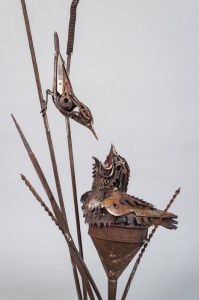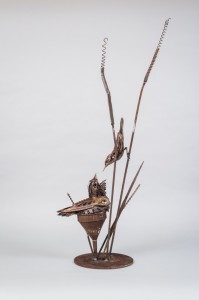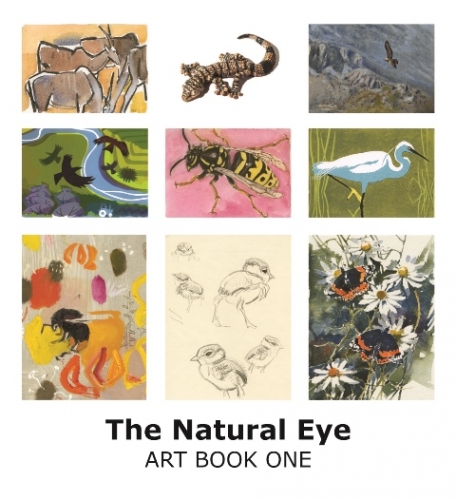The Wildlife Trusts have given this award for the last 5 years and I was thrilled to be chosen. It is an amazing opportunity to learn to dive and then use the experience of diving off the UK coast as inspiration for work to celebrate the diversity of life off our shores. Being based in Norfolk it seemed a perfect opportunity to explore the relatively newly explored Cromer shoal chalk beds off the North Norfolk coast.

The dive training was pretty straightforward, although I was quick to learn that nothing involved with diving can be performed in an elegant way on dry land. One ends up feeling like a zombie with a toddler’s capacity for achievement. Straps, buckles and zips become major triumphs to undo or do up and movement with all the kit on is a mammoth task. Once under the water it is a different matter with the whole weight lifted by the water and everything that was a hindrance becomes a help. The first thing that strikes you is how noisy it is with every exhaled breath bubbling past your mask. You soon get used to it but it makes you very aware of your breathing.

The chalk shoal off the North Norfolk coast is an amazing haven for all sorts of marine life. Despite fairly poor visibility I was blessed with views of edible crab, shore crab, spider crab, lobster and shrimp. The gobies darting around on the sand were so well camouflaged they were only visible when they moved. The crabs were ever present in the gullies and cracks of the chalk reef. A small lobster braved it out with me waving its claws in defiance as it marched backwards to find shelter in the rocks.

My attempts at drawing it were comical. It would be difficult enough with just the thick gloves to contend with but five metres underwater with cold hands I found the super thick watercolour paper bulldog clipped to a chopping board was not the best idea. Swapping sheets of paper was hampered by the cold and the graphite sticks anchored by string to the board. Thankfully with the help of my bemused dive buddy Kate Risely the bulldog clips got back on before the drawings were claimed by the current. As we made our way back Kate pointed out the shadow of something, the suggestion of a fan perhaps and then suddenly I could see it was a flat fish probably a dab settled in the sand with its tell tale fins giving Kate the clue to its presence.

The second dive was on the wreck of the Rosalie and I was rewarded with the astonishing sight of walls of anenomes crusting every surface of the second world war vessel. Wrasse and bib made their homes here amongst the architecture of the collapsing deck and it was easy to forget this was iron not rock that was host to this amazing mass of life. A much bigger lobster and the colourful sea scorpions were showy compared with the rather messy looking spider crabs self adorned with algae and weed. Despite my inexperience I followed Kate around parts of the wreck finning under beams as we delighted in the sugar pink nudibranch or sea slugs and tiny skeleton shrimps nestled among the anenomes and sponges. Time was up on the wreck so we swam back across the sand bed that was punctuated by occasional little outcrops of chalk orientating ourselves by following the ripples of sand sculpted by the sea which was a clue that we were heading back to shore. Sharp eyed Kate found two immature greater pipefish that could easily be overlooked as detritus. They were amazing little fish like straightened out seahorses so it was easy to see that they are in the same family.

The highlight had to be the little cuttlefish, the size of a large bumblebee that turned black in front of my mask and then darted back with a small burst of ink. Its tactic is designed to divert the potential predator to allow it to escape but being so small it only managed to go away for a few inches. The next option it chose was to drop down to the sand where it disappeared in front of my eyes with one last shuffle of tentacles that swept the sand over its head. Stunning.

Back in the studio I had plenty of inspiration and trawled through my collection of old tools and scrap to find the perfect components for the underwater critters. Mole grips and secateurs helped describe the claws for the lobster and an old blade from a hedge trimmer was the basis for the abdomen with brake cables for the antennae. Padlocks were perfect for the base of the cuttlefish body and the centre of the crab’s carapace. Ring spanners and ball bearings became the prominent eyes on the goby with sawblades for its feathery fins.
I am now hooked and hope to do more dives soon so I am sure I will be making more sculptures of marine life from my experiences.
The Cromer Shoal Chalk Beds are recommended for a Marine Conservation Zone (MCZ). To support this recommendation visit wildlieftrusts.org/MCZ/cromer-shoal-chalk-beds






